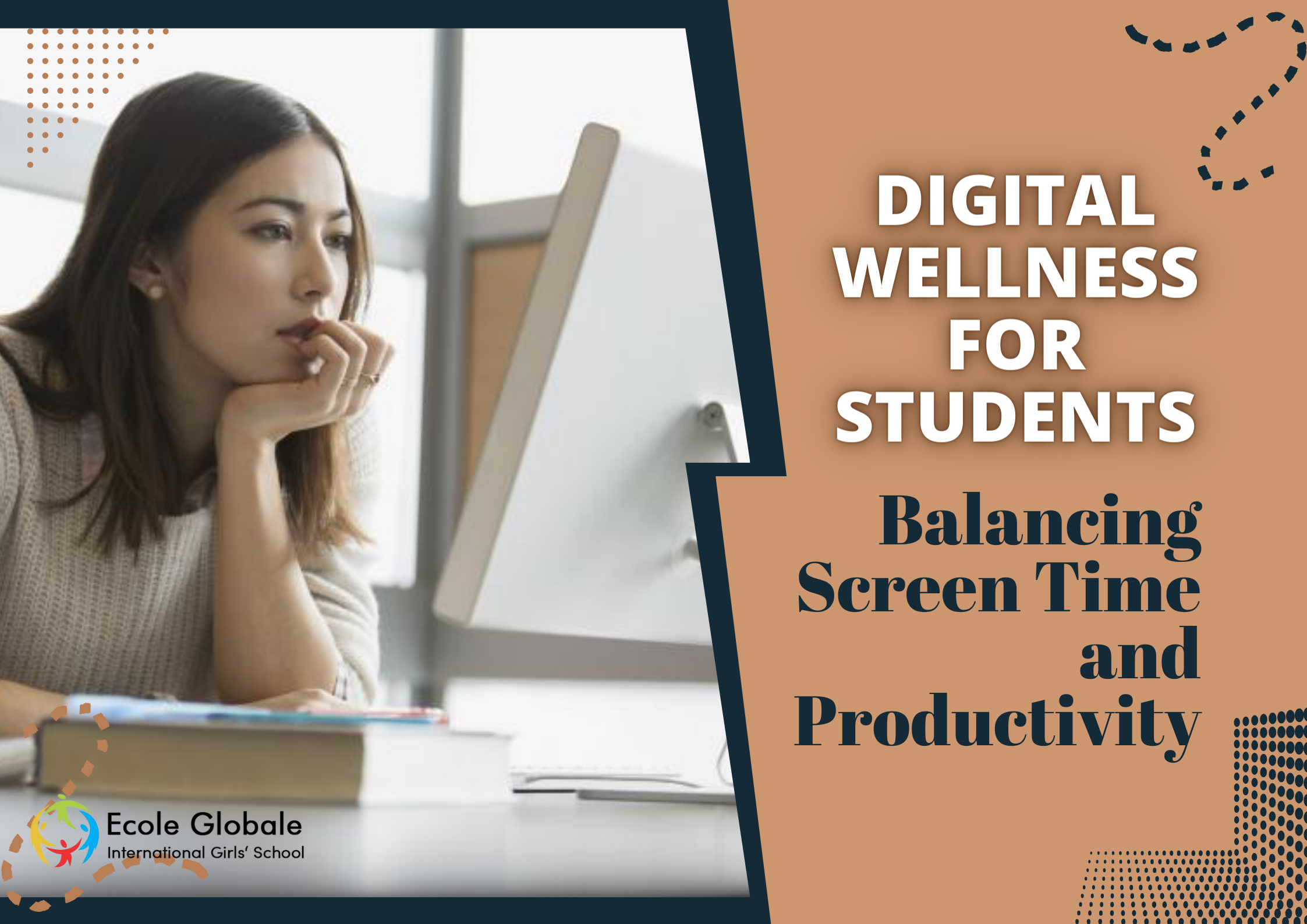In the digital age, students are more connected than ever, with screens playing a central role in education and daily life. However, this increased reliance on technology raises concerns about the potential impact on students’ well-being.
This article explores the concept of digital wellness, delving into the challenges posed by excessive screen time and offering practical strategies for achieving a balance between technology use and productivity.
Understanding Digital Wellness
Digital wellness encompasses the holistic approach to managing one’s relationship with technology to ensure a healthy and fulfilling life.
It involves being mindful of how technology impacts physical and mental well-being and actively seeking a balance between the benefits and drawbacks of digital engagement. For students, achieving digital wellness is crucial for maintaining academic success and overall quality of life.
While technology undoubtedly facilitates learning and provides valuable resources, it’s essential to recognize the need for moderation. Striking a balance between screen time and other aspects of life is key to fostering a sense of digital wellness.
Challenges of Excessive Screen Time for Students
Eye Strain and Physical Health Concerns
Prolonged screen time is often associated with physical health issues, the most common being eye strain. Staring at screens for extended periods can lead to discomfort, dry eyes, and headaches. These issues, if left unaddressed, can significantly impact a student’s ability to focus and perform well academically.
Mental Health Implications
The mental health implications of excessive screen time are well-documented. Increased levels of stress, anxiety, and even depression can result from the constant connectivity and pressure associated with academic and social interactions online. Striking a balance between digital engagement and mental well-being is essential for a student’s overall health.
Academic Performance and Distraction
While technology is a powerful tool for learning, it can also become a source of distraction. Social media, notifications, and other online temptations can divert attention away from essential academic tasks. Balancing the use of technology for productivity while avoiding distractions is a critical skill that contributes to both digital wellness and academic success.
The Relationship Between Screen Time and Productivity

Recognizing the intricate relationship between screen time and productivity is vital for students aiming to maximize the benefits of technology while minimizing its drawbacks.
Leveraging Technology for Effective Studying
Technology can be a powerful ally in academic pursuits. Educational apps, online resources, and collaborative platforms can enhance the learning experience. Students should explore and integrate technology that aligns with their study habits and aids in comprehension and retention of material.
Balancing Productive Screen Time with Healthy Breaks
While screens are integral to the learning process, it’s equally important to incorporate healthy breaks. The Pomodoro Technique, which involves short bursts of focused study followed by brief breaks, is one effective strategy. These breaks allow the mind to recharge and can contribute to sustained focus and productivity.
Establishing Healthy Digital Habits

Developing healthy digital habits is fundamental to achieving and maintaining digital wellness. Setting boundaries and creating a conducive digital environment are key components of this strategy.
Setting Boundaries on Screen Time
Establishing clear boundaries on screen time is essential. Designate specific periods for academic work, leisure activities, and screen-free time. By defining these boundaries, students can manage their time more effectively and reduce the risk of excessive screen exposure.
Creating a Conducive Digital Environment
The physical environment plays a crucial role in digital wellness. Ensure your study space is well-lit and ergonomically friendly. Consider blue light filters for screens to reduce eye strain, and invest in comfortable furniture that supports good posture during extended study sessions.
Implementing the “20-20-20” Rule for Eye Health
To mitigate the strain on your eyes, consider incorporating the “20-20-20” rule into your study routine. Every 20 minutes, take a 20-second break and focus on something 20 feet away. This simple practice helps reduce eye strain and promotes eye health.
Mindful Technology Use: Quality Over Quantity

Emphasizing the quality of screen time over sheer quantity is a fundamental aspect of mindful technology use.
Selecting Educational and Productivity Apps Mindfully
Not all apps are created equal. Choose educational and productivity apps that align with your academic goals and preferences. Evaluate their effectiveness in enhancing your learning experience and be willing to replace or limit the use of apps that do not contribute positively to your studies.
Incorporating Intentional Breaks for Non-Screen Activities
Mindful technology use involves recognizing when to step away from screens. During breaks, engage in non-screen activities such as stretching, reading a physical book, or going for a short walk. Diversifying activities during breaks contributes to a more balanced and fulfilling study routine.
Cultivating a Healthy Work-Life-Tech Balance

Achieving a harmonious balance between academic requirements, personal activities, and screen time is crucial for digital wellness.
Balancing Academic Requirements with Personal and Leisure Activities
While academic commitments are a priority, it’s equally important to allocate time for personal and leisure activities. Maintaining a healthy balance between work and leisure contributes to overall well-being and prevents burnout.
The Role of Physical Activities
Combat the sedentary nature of extended screen time by incorporating physical activities into your routine. Exercise has numerous benefits for both physical and mental health, and integrating it into your schedule can enhance your overall well-being.
Establishing a Structured Daily Routine
Create a structured daily routine that includes dedicated time for academic pursuits, personal activities, and screen-free periods. A well-organized routine provides a framework for managing your time effectively and reduces the likelihood of succumbing to excessive screen time.
Digital Detox and Its Benefits

Recognizing when a digital detox is necessary can be a transformative aspect of digital wellness.
Knowing When a Digital Detox Is Necessary
If you find yourself feeling overwhelmed, experiencing heightened stress, or noticing negative effects on your well-being due to excessive screen time, it may be time for a digital detox. Acknowledge the signs and prioritize your mental and physical health.
The Potential Benefits of a Temporary Break from Screens
A digital detox offers numerous benefits, including improved focus, reduced stress levels, and enhanced sleep quality. Taking a step back from screens allows for a reset, enabling you to return to your digital devices with a refreshed perspective and greater appreciation for mindful technology use.
Strategies for Implementing a Successful Digital Detox
Plan your digital detox strategically. Inform your peers, set clear goals, and engage in alternative activities during this period. Whether it’s a day or a weekend, a digital detox can be a rejuvenating experience that contributes positively to your overall well-being.
Promoting Digital Wellness in Educational Institutions

Educational institutions play a pivotal role in promoting digital wellness among students.
The Responsibility of Educational Institutions
Educational institutions should recognize their responsibility in fostering digital wellness. Implementing policies and educational programs that promote healthy technology use can contribute to a positive learning environment.
Integrating Digital Wellness into the Curriculum
Digital wellness should be integrated into the curriculum to educate students about the importance of balance and mindfulness in their use of technology. Courses or workshops that address digital well-being can empower students to make informed choices about their screen time.
Providing Resources and Support
Institutions should provide resources and support systems to help students navigate the challenges of digital wellness. Counseling services, workshops, and access to digital well-being tools can contribute to a supportive and holistic educational environment.
The Role of Peer Support and Communication

Encouraging open communication among peers about digital wellness fosters a sense of community and shared responsibility.
Sharing Strategies for Managing Screen Time
Students can play a vital role in supporting each other’s digital wellness by openly sharing strategies for managing screen time. Peer discussions can provide insights into effective techniques and foster a sense of camaraderie in navigating the digital landscape.
Building a Supportive Community
Creating a supportive community that values well-being over constant connectivity is crucial. Peer support can be a powerful motivator in establishing and maintaining healthy digital habits. Encourage discussions about the challenges and successes of balancing screen time within your academic community.
Monitoring and Reflecting on Digital Habits

Regularly monitoring and reflecting on digital habits are essential components of maintaining digital wellness.
Utilizing Digital Well-Being Tools and Apps
Digital well-being tools and apps are designed to help individuals monitor and manage their screen time. Utilize these tools to gain insights into your usage patterns, set goals for screen time, and receive reminders to take breaks.
Reflecting on Personal Digital Habits
Periodically reflect on your digital habits and their impact on your well-being. Consider journaling about your experiences, noting moments of increased stress, productivity, or overall satisfaction with your digital engagement. Use these reflections to make informed adjustments to your habits.
Creating a Sustainable and Evolving Approach
Digital wellness is an ongoing journey that requires a sustainable and evolving approach. Recognize that your needs and circumstances may change, and be willing to adjust your digital habits accordingly. Cultivate a mindset that prioritizes well-being and adaptability in the digital landscape.
Conclusion
In conclusion, achieving digital wellness as a student involves intentional and mindful management of screen time. Balancing the benefits of technology with the potential drawbacks requires strategic planning, healthy habits, and a commitment to overall well-being.
By understanding the challenges posed by excessive screen time, recognizing the relationship between screen time and productivity, and adopting healthy digital habits, students can navigate the digital landscape successfully.
Cultivating a healthy work-life-tech balance, incorporating intentional breaks, and knowing when a digital detox is necessary are crucial elements of achieving digital wellness. Educational institutions can contribute by integrating digital wellness into the curriculum, providing resources and support, and fostering a supportive community.
As students embark on their academic journeys in the digital age, embracing a holistic approach to technology use will not only enhance their academic performance but also contribute to their overall happiness and well-being.
Strive for a balance that promotes mindful technology use and empowers yourself to thrive in the digital era while maintaining a healthy and fulfilling life.










